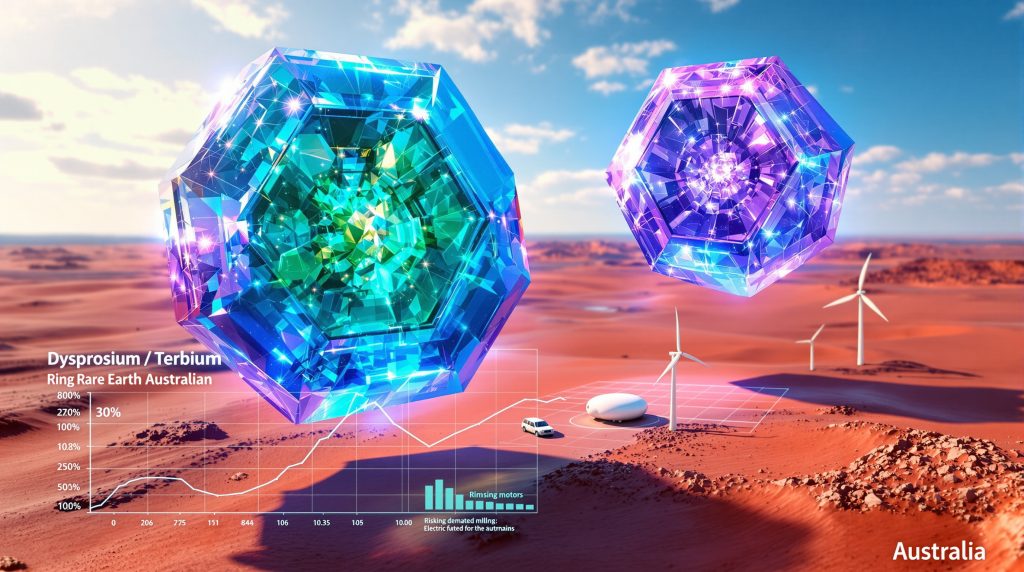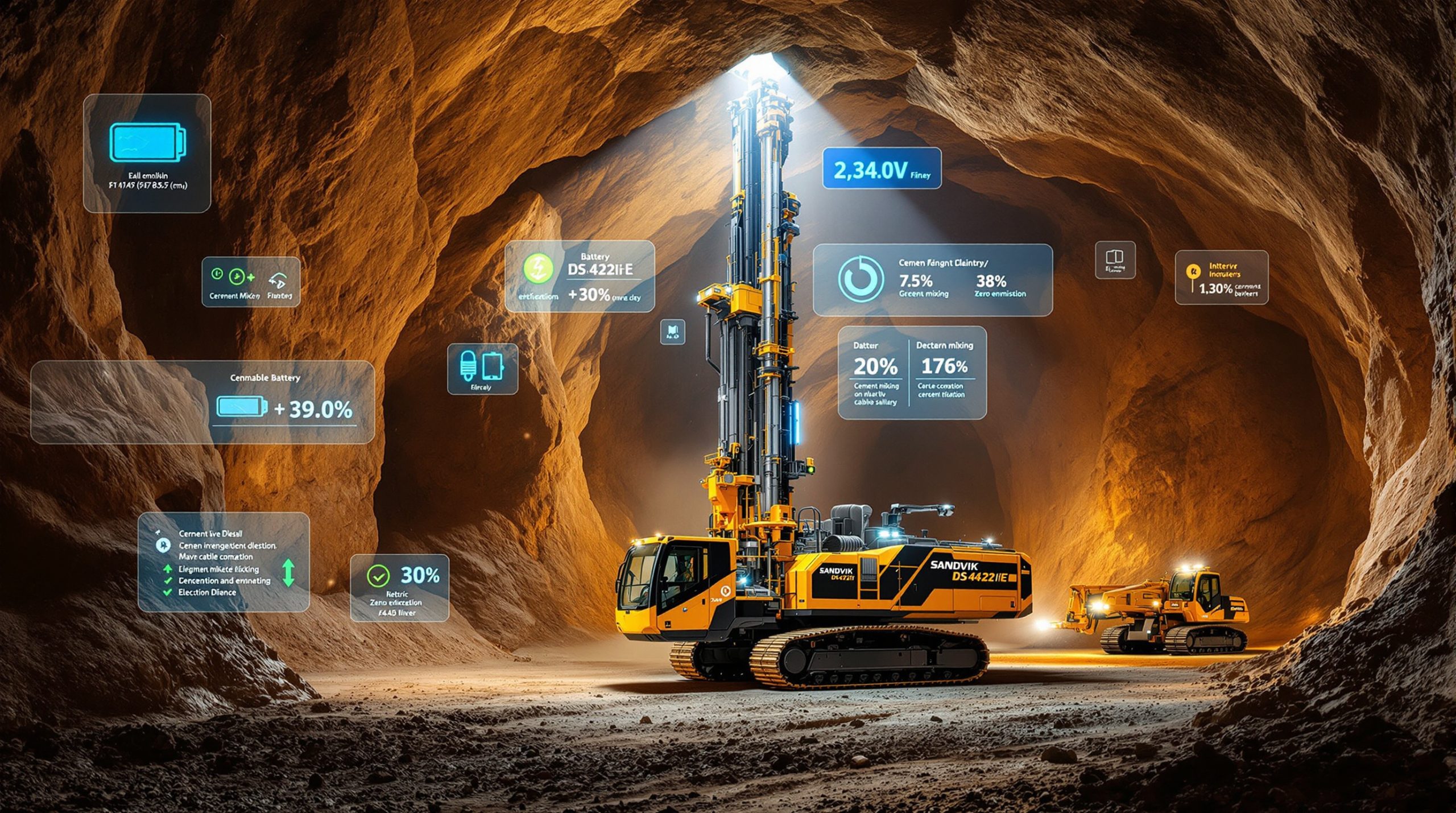North Stanmore: A Global Powerhouse for Critical Heavy Rare Earth Elements
North Stanmore in Western Australia has emerged as one of the world's most extraordinary heavy rare earth element (HREE) deposits, particularly for dysprosium and terbium in North Stanmore. With unprecedented enrichment levels revealed through recent drilling programs, this project stands poised to become a strategically vital resource in the global rare earths landscape, potentially reshaping supply chains for these critical minerals.
Record-Breaking Dysprosium and Terbium Concentrations
The most recent infill aircore drilling at North Stanmore has yielded remarkable results, with concentrations reaching up to 218 parts per million (ppm) dysprosium oxide. This exceptional grade places North Stanmore among the world's most enriched heavy rare earth deposits discovered to date. Even more impressive, previous drilling campaigns returned values exceeding 550ppm dysprosium oxide, highlighting the project's extraordinary potential.
Terbium concentrations have also proven exceptional, reaching up to 32ppm – a figure that significantly exceeds typical concentrations found in comparable deposits globally. These consistent high-grade results demonstrate robust mineralization continuity across the deposit, providing confidence in the resource's quality and potential economic viability.
Victory Metals CEO Brendan Clark has emphasized the significance of these findings, stating that the results confirm the unique nature of this discovery, particularly given that dysprosium and terbium represent two of the most critical minerals in today's market.
Extraordinary Natural Enrichment Factors
What makes North Stanmore truly remarkable is the degree of natural enrichment observed in its heavy rare earth content. The project's dysprosium concentration is approximately 54 times higher than natural crustal abundance, which averages just 3.5ppm in the Earth's upper continental crust.
Similarly, terbium levels significantly exceed typical crustal abundance of 0.64ppm. This level of enrichment is virtually unprecedented in regolith-hosted ionic clay deposits globally, setting North Stanmore apart from other rare earth projects. The absence of problematic radioactive elements further enhances the deposit's economic value, as it potentially simplifies processing requirements and environmental management.
Geological experts note that this extraordinary enrichment reflects the unique geochemistry of the project's underlying source intrusion, combined with the effects of oxidation on rare earth element mobility during periods of intense chemical weathering. This natural concentration process has created an ideal environment for heavy rare earth accumulation.
How Did North Stanmore's Rare Earth Deposit Form?
Unique Geological Formation Mechanisms
The exceptional rare earth concentrations at North Stanmore can be attributed to a series of geological processes that occurred over millions of years. The distinctive geochemistry of the underlying source intrusion provided the initial rare earth enrichment, creating the foundation for what would eventually become a world-class deposit.
Subsequently, intense chemical weathering processes worked to concentrate these valuable elements further. The region's historical climate patterns, which likely included alternating wet and dry periods, accelerated the decomposition of primary minerals and facilitated the release of rare earth elements into solution.
Oxidation enhanced the mobility and subsequent concentration of rare earth elements, particularly the heavier elements like dysprosium and terbium. This process typically involves the breakdown of rare earth-bearing minerals in the source rock, followed by selective leaching, transportation, and re-precipitation of the elements in the weathering profile.
The culmination of these natural geological processes created an ideal environment for heavy rare earth accumulation, resulting in the exceptional grades now being reported. Importantly, these processes occurred without concentrating problematic radioactive elements like uranium and thorium, which often accompany rare earth deposits and can complicate processing and environmental management.
Clay-Hosted Mineralization Advantages
The North Stanmore deposit represents a clay-hosted ionic rare earth system, which offers several distinct advantages over hard-rock rare earth deposits. Ionic clay deposits typically allow for simpler processing methods, often involving simple leaching techniques rather than complex crushing, grinding, and chemical processing required for hard-rock deposits.
The surface or near-surface nature of the mineralization enables lower-cost extraction techniques, potentially allowing for shallow open-pit mining methods that minimize stripping ratios and reduce overall mining costs. This shallow nature also facilitates faster and less expensive exploration programs, as evidenced by Victory Metals' successful aircore drilling campaigns.
From an environmental perspective, clay deposits often present a smaller footprint than hard-rock mining operations. The processing pathways typically require fewer chemicals and energy inputs, potentially reducing the project's overall environmental impact and carbon footprint.
Perhaps most significantly, clay deposits can offer faster paths to production compared to hard-rock alternatives. The simpler processing requirements and reduced capital intensity mean that development timelines can be substantially shorter, allowing projects to move from discovery to production more rapidly in response to market demand.
What Resource Potential Does North Stanmore Hold?
Substantial Mineral Resource Estimate
In August 2025, Victory Metals announced a Mineral Resource Estimate of 320.6 million tonnes for North Stanmore, with the majority of the resource classified in the indicated category. This high confidence classification demonstrates the thoroughness of the exploration work completed to date and provides a solid foundation for future development studies.
The substantial scale of this resource positions North Stanmore as one of the largest known heavy rare earth deposits globally. With significant potential for resource expansion through additional exploration, the ultimate size of the deposit could prove even more impressive.
Preliminary economic assessments, while not yet publicly detailed, suggest robust project economics based on the high-value nature of the contained rare earth elements. Industry analysts anticipate that the project could support a mining operation with an expected 10-year mine life focusing on high-value heavy rare earth zones, with potential for extension as additional resources are defined.
The deposit's location in Western Australia—a jurisdiction with well-established mining regulations and infrastructure—further enhances its development potential, potentially allowing for streamlined permitting and development processes.
Heavy Rare Earth Oxide Distribution
What truly sets North Stanmore apart from many other rare earth deposits is its exceptionally high HREO (Heavy Rare Earth Oxide) to TREO (Total Rare Earth Oxide) ratio. While specific numbers from Victory Metals have not been released, the consistent high-grade dysprosium and terbium results suggest a ratio that could approach 83% HREO:TREO—significantly higher than most other deposits globally.
The deposit contains multiple valuable heavy rare earths beyond dysprosium and terbium. Additional strategic elements likely include yttrium, scandium, hafnium, lutetium, and thulium—all of which have critical applications in high-technology industries and command premium prices in the marketplace.
This balanced distribution of elements enhances the overall project economics, as it provides exposure to multiple high-value rare earth markets rather than relying on a single element. The minimal presence of deleterious elements simplifies processing requirements, potentially allowing for more straightforward extraction and separation processes that could reduce overall production costs.
Why Are Dysprosium and Terbium Considered Critical Minerals?
Essential Components in Advanced Technologies
Dysprosium and terbium are indispensable in manufacturing high-performance neodymium-iron-boron (NdFeB) magnets, which form the backbone of many modern technologies. These elements are critical for improving heat resistance in permanent magnets, enabling them to maintain their magnetic properties at elevated temperatures—a crucial requirement for applications like electric vehicle motors.
The addition of dysprosium to NdFeB magnets can increase their maximum operating temperature from approximately 80°C to over 200°C, enabling higher efficiency in electric vehicle motors and wind turbine generators. Without these elements, many clean energy technologies would face significant performance limitations or require substantial redesign.
These elements are also essential in miniaturized electronics and precision guidance systems, where their unique magnetic properties enable device miniaturization while maintaining or improving performance. In consumer electronics, they contribute to smaller, more powerful speakers, vibration motors, and hard disk drives.
Perhaps most critically, dysprosium and terbium are irreplaceable in various defense applications including radar systems, missile guidance technology, and other advanced military systems. Their strategic importance in national security applications has elevated their status to "critical minerals" in many countries.
Supply Chain Vulnerabilities
Both dysprosium and terbium have been designated as critical minerals by the US, EU, Japan, and Australia, reflecting growing concerns about supply chain security for these essential elements. This designation acknowledges both their economic importance and the risks associated with supply disruption.
China currently dominates global supply chains for these elements, controlling approximately 85% of global production. This concentration of supply creates inherent vulnerabilities for industries dependent on these materials, particularly as geopolitical tensions increase.
Recent export restrictions from China have heightened supply concerns among Western manufacturers and governments. In late 2024 and early 2025, China implemented new export control measures that limit the outflow of rare earth processing technologies and certain rare earth products, prioritizing domestic industries instead.
Western nations are actively seeking supply diversification for strategic reasons, with initiatives like the US Critical Minerals Strategy, the European Raw Materials Alliance, and Australia's critical minerals reserve all emphasizing the need to develop alternative supply sources outside China. This strategic imperative creates a favorable environment for projects like North Stanmore, which could potentially become significant non-Chinese sources of these critical elements.
What Are the Market Dynamics for Dysprosium and Terbium?
Premium Pricing Reflects Scarcity
The exceptional scarcity and critical applications of dysprosium and terbium are reflected in their premium pricing in global markets. As of September 2025, dysprosium oxide trades at approximately US$202.15/kg, representing one of the highest-value rare earth elements.
Terbium oxide commands even more impressive prices, currently around US$1,125.14/kg, placing it among the most valuable industrial metals. This premium pricing supports favorable project economics even at modest production volumes, potentially enabling profitable operations even at relatively small scales.
The price trajectory for both elements has shown a steady upward trend over the past 24 months, driven by growing demand from clean energy and defense applications coupled with supply constraints from China. This trend is expected to continue as global adoption of electric vehicles and renewable energy accelerates.
Notably, price volatility for heavy rare earths like dysprosium and terbium is typically lower than for lighter rare earths such as neodymium and praseodymium. This relative price stability can enhance the attractiveness of heavy rare earth projects for investors and financiers, potentially facilitating project development.
Growing Demand Forecast
| Application Sector | Projected Annual Growth Rate (2025-2030) | Key Demand Drivers |
|---|---|---|
| Electric Vehicles | 25-30% | Motor efficiency requirements, heat resistance needs |
| Wind Energy | 15-20% | Larger turbines, offshore installations |
| Defense Systems | 10-15% | Precision guidance, radar technologies |
| Consumer Electronics | 8-12% | Miniaturization, performance requirements |
| Industrial Automation | 12-18% | Precision motors, robotics advancement |
The demand outlook for dysprosium and terbium appears robust across multiple sectors. The electric vehicle market, which requires these elements for high-performance motors, is projected to grow at 25-30% annually through 2030. This growth is driven not only by increasing EV adoption but also by the trend toward more efficient motors that require higher dysprosium content.
Similarly, the wind energy sector is forecast to expand at 15-20% annually, with a particular emphasis on larger turbines and offshore installations that require more powerful and heat-resistant magnets. Defense applications continue to grow at 10-15% annually as military systems increasingly rely on advanced electronics and guidance systems.
Consumer electronics and industrial automation represent additional growth markets, with projected annual growth rates of 8-12% and 12-18% respectively. These sectors benefit from the miniaturization and performance improvements enabled by dysprosium and terbium-containing magnets.
How Does North Stanmore Compare to Other Global HREE Projects?
Competitive Advantages
North Stanmore possesses several significant competitive advantages compared to other heavy rare earth projects globally. Most notably, its higher grades of dysprosium and terbium than most global competitors potentially translate to better economics and lower production costs per kilogram of final product.
The clay-hosted mineralization offers potential processing advantages, including simplified extraction methods and reduced chemical consumption compared to hard-rock rare earth deposits. This could result in lower capital and operating costs, as well as a reduced environmental footprint.
Its location in politically stable Western Australia provides significant advantages in terms of regulatory certainty, infrastructure access, and political risk. The Western Australian government has demonstrated strong support for critical minerals development, creating a favorable environment for project advancement.
The region's established mining infrastructure and skilled workforce availability further enhance development prospects. Access to power, water, transportation networks, and experienced mining professionals can significantly reduce development timelines and costs compared to projects in more remote or less developed regions.
Finally, Australia's clear regulatory framework for development and permitting provides a pathway to production that is more predictable than in many other jurisdictions. This regulatory clarity can reduce project development risk and potentially accelerate the timeline from discovery to production.
Benchmark Against Global Competitors
| Project Attribute | North Stanmore | Typical Clay HREE Projects | Hard Rock HREE Projects |
|---|---|---|---|
| Dysprosium Grade | Up to 218ppm | 30-80ppm | 200-400ppm |
| HREO:TREO Ratio | ~83% | 25-40% | 10-35% |
| Processing Complexity | Moderate | Moderate | High |
| Capital Intensity | Moderate | Moderate | Very High |
| Time to Production | 2-3 years | 3-4 years | 5-7+ years |
When benchmarked against global competitors, North Stanmore demonstrates several distinctive characteristics. Its dysprosium grades of up to 218ppm exceed those of typical clay-hosted HREE projects (30-80ppm) while approaching the grades seen in some hard rock projects (200-400ppm). However, it achieves these grades without the processing complexity associated with hard rock deposits.
The project's estimated HREO:TREO ratio of approximately 83% significantly exceeds both typical clay projects (25-40%) and hard rock projects (10-35%), highlighting the exceptional heavy rare earth enrichment that sets North Stanmore apart.
In terms of development parameters, North Stanmore shares the moderate processing complexity and capital intensity typical of clay projects, but potentially offers a faster path to production (2-3 years) compared to both typical clay projects (3-4 years) and especially hard rock projects (5-7+ years).
What Development Path Is Victory Metals Pursuing?
Strategic Development Timeline
Victory Metals is advancing North Stanmore along a strategic development timeline designed to bring this critical resource to market efficiently. Currently, an extensive drilling program is underway to further define resource boundaries and potentially expand the resource base beyond the already substantial 320.6 million tonnes.
Concurrent with this drilling program, metallurgical testing is advancing to optimize processing methods for the unique mineralogy of the North Stanmore deposit. This work is crucial for determining the most efficient and environmentally responsible extraction techniques for the valuable heavy rare earths.
Environmental baseline studies are also in progress, collecting the comprehensive data needed for future permitting applications and environmental impact assessments. This proactive approach to environmental characterization demonstrates Victory Metals' commitment to responsible development practices.
A prefeasibility study is targeted for completion in Q2 2026, which will provide detailed technical and economic parameters for the project. This study will incorporate the results of current drilling, metallurgical, and environmental programs to develop a comprehensive development plan.
Based on this timeline, North Stanmore has production potential as early as 2028-2029, positioning it to enter the market during a period of projected strong demand growth for heavy rare earths. This timeline represents a relatively rapid path to production compared to many other rare earth projects globally.
Processing Innovation Focus
Victory Metals is placing significant emphasis on processing innovation at North Stanmore, investigating environmentally optimized extraction techniques that minimize both environmental impact and operational costs. The company is evaluating direct extraction methods that could potentially eliminate or reduce the need for conventional processing steps like crushing and grinding.
The company is also exploring partnerships with end-users for offtake agreements, recognizing the strategic importance of securing market access before production begins. Such agreements could potentially provide development funding while guaranteeing future revenue streams.
Downstream processing opportunities within Australia are being considered as part of a strategy to capture more value from the resource. This could involve producing separated rare earth oxides rather than just mixed rare earth concentrates, potentially multiplying the project's economic impact.
Integration potential with renewable energy systems is also being assessed as part of Victory Metals' commitment to sustainable mining transformation. Solar and wind power could potentially provide a significant portion of the project's energy requirements, reducing both carbon footprint and operating costs.
How Does North Stanmore Support Global Clean Energy Transition?
Critical Supply Chain Component
North Stanmore represents a critical potential supply chain component for the global clean energy transition. The project could provide essential materials for permanent magnets in wind turbines, which rely on dysprosium and terbium to maintain performance at high temperatures and under challenging operating conditions.
These same materials enable more efficient electric vehicle motors, potentially increasing range and performance while reducing battery requirements. The efficiency improvements enabled by dysprosium-enhanced magnets can translate to significant energy savings across the EV lifecycle.
The project also supports grid stabilization technologies, which increasingly rely on high-performance magnets for functions like frequency regulation and power quality management. As renewable energy penetration increases, these stabilization technologies become increasingly important for maintaining grid reliability.
Additionally, North Stanmore's output could contribute to energy storage system advancement, particularly in emerging technologies like flywheel energy storage that rely on high-performance magnetic components. These systems will play a crucial role in managing the intermittency of renewable energy sources.
By providing these essential materials, North Stanmore could help reduce the overall carbon footprint of renewable technologies by enabling more efficient designs and potentially reducing material requirements for equivalent performance.
Strategic Importance to Western Nations
North Stanmore offers supply diversification away from Chinese dominance, addressing a key vulnerability in Western clean energy supply chains. This diversification is increasingly viewed as a national security priority by many Western governments.
The project supports domestic manufacturing capabilities for clean tech by providing secure access to critical inputs. This could help rebuild Western manufacturing capacity in sectors like permanent magnets, which have largely shifted to Asia over recent decades.
North Stanmore aligns perfectly with critical mineral strategies of multiple governments, including the US, EU, Australia, and Japan, all of which have identified heavy rare earths as priority materials for supply chain security. This alignment could potentially facilitate government support for project development.
The project could serve as a potential catalyst for rare earth processing capabilities outside China, helping to address a key supply chain vulnerability. Currently, China dominates not only rare earth mining but also the more valuable downstream processing and separation activities.
By addressing these strategic priorities, North Stanmore creates an opportunity for vertically integrated supply chains that reduce dependence on potentially unreliable foreign sources for critical materials.
What Environmental Considerations Apply to the Project?
Sustainable Development Approach
North Stanmore's clay-hosted deposit type typically requires less invasive mining methods compared to hard-rock rare earth mining. Surface mining techniques can be employed with minimal blasting and deep excavation, reducing both environmental impact and operational costs.
The project is expected to have lower energy requirements compared to hard-rock mining, which typically involves energy-intensive crushing and grinding operations. This reduced energy intensity translates to both cost savings and lower greenhouse gas emissions.
Chemical processing needs are also reduced compared to conventional rare earth extraction, which often involves aggressive acid leaching and multiple processing steps. The ionic nature of the rare earths in clay deposits often allows for simpler extraction using milder reagents.
The project offers progressive rehabilitation opportunities during operations, potentially allowing for concurrent mining and rehabilitation that minimizes the active disturbance footprint. This approach can significantly reduce the project's overall environmental impact.
Victory Metals is designing water management systems for minimal environmental impact, recognizing that water management represents one of the key environmental considerations for any mining operation. Closed-loop systems and water recycling technologies are being evaluated to minimize freshwater consumption.
Environmental Management Strategies
Comprehensive baseline environmental studies are currently underway, collecting detailed data on biodiversity, water resources, air quality, and other environmental parameters. This information will inform both project design and future environmental management strategies.
Stakeholder engagement programs have been established with local communities to ensure that community concerns and priorities are incorporated into project planning. This collaborative approach can help identify and address potential issues early in the development process.
Biodiversity conservation plans are being developed based on the findings of baseline studies, with a focus on minimizing habitat disturbance and implementing effective mitigation measures where impacts are unavoidable. These plans will be crucial for securing regulatory approvals.
Water recycling and minimization strategies are being incorporated into project design from the earliest stages, recognizing that water management represents both an environmental priority and a potential operational constraint. Advanced filtration and recycling technologies are being evaluated to maximize water efficiency.
Carbon reduction initiatives are planned for operations, including potential renewable energy integration, energy efficiency measures, and low-carbon equipment selection. These initiatives align with both environmental best practices and potential future carbon pricing mechanisms.
What Are the Investment Implications of North Stanmore's Development?
Value Creation Potential
North Stanmore represents a strategic asset in critical mineral supply chains, potentially commanding premium valuations due to its strategic importance. As governments and industries increasingly prioritize supply chain security, projects like North Stanmore that address key vulnerabilities may be valued beyond traditional resource metrics.
The project offers exposure to high-value heavy rare earth markets, which typically command higher prices and experience less price volatility than light rare earths. This market exposure could potentially provide more stable returns compared to other mineral commodities.
Potential for premium pricing exists due to exceptional product quality, particularly the high concentration of dysprosium and terbium relative to total rare earth content. This favorable product mix could potentially command premium pricing from specialized end-users.
Multiple development pathways are available to maximize returns, including various processing options, potential downstream integration, and strategic partnerships. This flexibility allows Victory Metals to adapt its development strategy to evolving market conditions and opportunities.
Growing market demand supports the long-term value proposition, with multiple industry forecasts predicting substantial growth in heavy rare earth demand through 2030 and beyond. This demand growth is driven by structural factors like electrification and renewable energy adoption, rather than cyclical economic factors.
Risk Factors to Consider
Rare earth price volatility can impact project economics, although heavy rare earths typically experience less price volatility than light rare earths. Potential investors should consider sensitivity analyses that account for various price scenarios.
Processing technology selection is critical to operational success, with different extraction and separation technologies offering different trade-offs between capital cost, operating cost, recovery rates, and environmental impact. Technology risk remains a significant consideration for all rare earth projects.
Potential for new market entrants creating competition exists, particularly as rare earth prices remain elevated and strategic concerns drive exploration and development funding. However, the specialized nature of heavy rare earth deposits provides some protection against oversupply.
Regulatory changes could affect the development timeline, particularly as governments increasingly focus on both securing critical mineral supplies and ensuring environmentally responsible development. These dual priorities can sometimes create regulatory complexity.
Market concentration risks exist with a limited number of end-users, particularly for separated heavy rare earth products. The relatively small size of these specialized markets means that relationship management with key customers becomes especially important.
Frequently Asked Questions About Dysprosium and Terbium
What makes dysprosium and terbium different from other rare earths?
Dysprosium and terbium belong to the heavy rare earth element group and possess unique magnetic and electronic properties that make them irreplaceable in high-performance permanent magnets. Unlike lighter rare earths, they maintain magnetic performance at higher temperatures, which is essential for applications like electric vehicle motors and wind turbines.
Their ability to stabilize magnetic properties at elevated temperatures (up to 200°C) enables magnets to operate in demanding environments without demagnetization. Additionally, their electronic configurations create unique luminescent properties used in specialized lighting, displays, and sensor applications.
Heavy rare earths like dysprosium and terbium are typically more scarce in economically viable concentrations than light rare earths, contributing to their higher market value and strategic importance. Their distribution in nature is also more limited, with fewer commercially viable deposits identified globally.
Why are these elements so expensive compared to other metals?
Their scarcity in economically viable concentrations drives premium pricing, with dysprosium and terbium typically found at very low concentrations even in dedicated rare earth deposits. The North Stanmore grades, while exceptional for a clay deposit, still represent parts per million rather than percentage concentrations.
Processing complexities further contribute to high costs, as rare earth separation requires multiple complex chemical processes to achieve high purity levels. The similar chemical properties of rare earth elements make separation particularly challenging and energy-intensive.
Critical applications in high-tech and defense industries create inelastic demand, as there are often no viable substitutes for these elements in their key applications. This inelasticity allows producers to command premium prices even during economic downturns.
Additionally, supply constraints from China, which controls approximately 85% of global production, create market pressures that support higher prices. Recent export restrictions have further tightened global supply, putting upward pressure on prices outside China.
Can other elements substitute for dysprosium and terbium?
Currently, no viable substitutes exist that can provide the same temperature stability and magnetic performance in permanent magnets. Extensive research into alternatives has yet to yield commercially viable replacements, making these elements truly critical for modern technology.
Research into reduced-dysprosium magnet formulations has shown some promise but typically results in performance trade-offs that limit applicability in demanding applications like electric vehicles and wind turbines. These reduced formulations often require design compromises like additional cooling systems.
Alternative magnet technologies such as samarium-cobalt can provide high-temperature performance but come with their own supply chain concerns and typically higher costs. They also generally offer lower magnetic strength, requiring larger and heavier magnets for equivalent performance.
Non-rare-earth magnetic materials like ferrites lack the performance characteristics needed for advanced applications, particularly in terms of size-to-power ratio and temperature stability. While suitable for many consumer applications, they cannot match the performance of rare-earth magnets in high-end applications.
How volatile are dysprosium and terbium prices?
While prices can fluctuate based on supply-demand dynamics and geopolitical factors, heavy rare earths like dysprosium and terbium typically experience less volatility than lighter rare earths. Their essential nature in critical applications and limited substitutability provide price support even during market downturns.
Historical price data shows that while significant price spikes have occurred (notably during the 2010-2011 rare earth crisis), dysprosium and terbium have generally maintained more stable price trajectories than elements like neodymium and praseodymium. This relative stability enhances their attractiveness for long-term investment.
The specialized nature of their end markets, which include defense, high-end electronics, and advanced manufacturing, provides some insulation from broader economic cycles. Demand from these sectors tends to be less correlated with general economic conditions than many other commodity markets.
Recent export restrictions from China have created some price divergence between Chinese domestic and international markets, with prices outside China typically commanding significant premiums. This divergence highlights the importance of developing non-Chinese supply sources like North Stanmore.
Further Exploration
Readers interested in learning more about rare earth elements and their applications can explore related educational content from SmallCaps, which offers market insights on critical minerals and emerging resource projects. Additional resources include government publications on critical minerals strategy, industry reports on rare earth markets, and technical publications on rare earth processing technologies.
Understanding the dynamics of this specialized market requires ongoing education, as technological developments, policy changes, and market conditions continue to evolve rapidly. The strategic importance of heavy rare earths like dysprosium and terbium ensures that they will remain a focus of attention for investors, policymakers, and technology developers for the foreseeable future.
The development of North Stanmore comes at a critical time when green mining innovation and Australia's green metals leadership are positioning the country to play a pivotal role in the global transition to clean energy technologies.
Looking to Spot Major Mineral Discoveries Before the Market?
Discover why significant finds like North Stanmore's rare earth deposit can deliver exceptional returns by exploring Discovery Alert's dedicated discoveries page. Our proprietary Discovery IQ model provides real-time alerts on significant ASX mineral discoveries, giving you the market-leading edge needed to capitalise on these opportunities ahead of the crowd.




